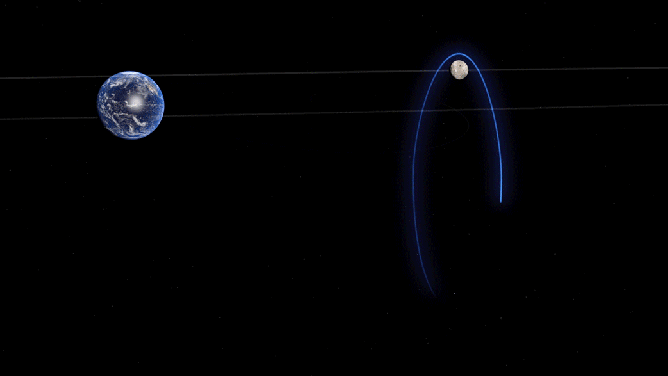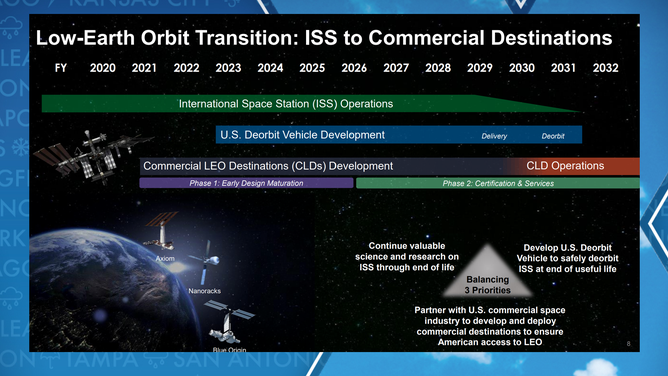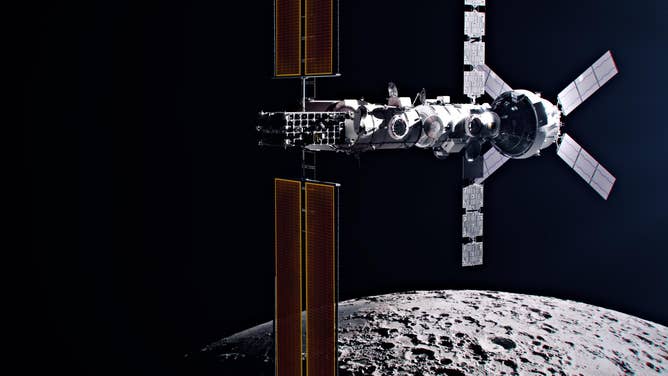See renderings of space station to be built around the Moon
There are currently two space stations orbiting Earth: The International Space Station, operated by the U.S., Russia, Europe, Canada and Japan and the Tiangong space station, operated by China. The ISS is set to be decommissioned after 2030 after more than three decades in service.
See what's new in the journey to reach the Moon
What's next for exploration of Earth's only natural satellite.
WASHINGTON – NASA and its fellow partners are in the development stage of a new, long-term space station that will orbit near the Moon and serve as a gateway for missions to the lunar body and Mars.
According to the space agency, the first modules of what is called the Lunar Gateway are slated to start arriving in space in 2025, with operations beginning no earlier than 2028.
Similar to the International Space Station, the mission will be a joint effort by the U.S., Europe, Japan, Canada and the United Arab Emirates and will likely run into the billions of dollars.
Unlike the ISS that operates in low Earth orbit, the Gateway will be on what is known as a near-rectilinear halo orbit, hovering between Earth and the Moon.

Animation of Gateway’s near-rectilinear halo orbit around the Moon
(NASA)
At its closest point, the station will operate less than 2,000 miles away from the lunar surface during its weeklong orbit.
"We are in a new era of exploration through Artemis – strengthened by the peaceful and international exploration of space. The UAE’s provision of the airlock to Gateway will allow astronauts to conduct groundbreaking science in deep space and prepare to one day send humanity to Mars," NASA Administrator Bill Nelson said in January after the Middle Eastern country announced its collaboration.
SEE THE OBJECTS HUMANS LEFT BEHIND ON THE MOON
According to NASA, the Gateway will serve as a space station where astronauts can work, stage for future missions and conduct spacewalks.
Gateway’s first two modules are reportedly in the construction phase by Maxar and Northrop Grumman and will launch aboard a SpaceX Falcon Heavy rocket from Florida’s Kennedy Space Center.
During the Artemis IV mission, four astronauts are slated to arrive at the lunar space station and activate its computer systems.
Two crew members will then depart the Gateway and are expected to spend six days on the Moon, while the other team remains in the space station conducting research and continuing setup activities.
According to NASA, all will meet up again at the Gateway, prior to departing for Earth aboard an Orion spacecraft.
The space agency has not stated if it is considering adding or allowing private missions to the new space station, but if adjustments to schedules aren’t made, the earliest humans would return would be aboard Artemis V in 2030.
If not delayed, the launch of Artemis V would roughly coincide with the end of operations aboard the International Space Station.
SEE WHAT NASA’S NEXT DECADE OF SPACE EXPLORATION LOOK LIKE, DESPITE PROPOSED BUDGET CONSTRAINTS
NASA planning to wind down operations aboard International Space Station
Space agencies around the globe are planning to wind down operations at the International Space Station around 2030 after decades in operation.
The agency says temperatures, pressures, and other elements in space are simply too extreme for a structure to remain indefinitely in operation.
NASA is in the planning stages of launching a deorbit vehicle that it hopes will help guide the ISS to a safe ending.
The deorbit vehicle will allow for the then-defunct space station to maneuver before it plummets to Earth over an uninhabited area of an ocean, minimizing threats to humans.

NASA space station timeline
(NASA)


